“Results to date suggest that sidewalks and multi-use trails pose the highest risk… and the presence of bicycle facilities (e.g. on-road bike routes, on-road marked bike lanes, and off-road bike paths) was associated with the lowest risk.”
There’s a constant chorus — sometimes soft, sometimes overpoweringly loud — in every conversation about bike infrastructure in America. Its refrain: You’re safer without any bike lanes, separated lanes, cycle tracks, bike boulevards, off-road paths. Just take the lane, follow the rules, wear your helmet, and you’ll be fine.
A group of scholars at the University of British Columbia have found otherwise. They conducted a literature review, looking at all available studies linking bicycle safety with infrastructure. Their conclusions will be counterintuitive for some.
“Results to date suggest that sidewalks and multi-use trails pose the highest risk, major roads are more hazardous than minor roads, and the presence of bicycle facilities (e.g. on-road bike routes, on-road marked bike lanes, and off-road bike paths) was associated with the lowest risk.”
That’s right — riding on sidewalks and multi-use trails is less safe than riding on major roads. The studies surveyed found that riding on the sidewalk resulted in risks 1.8 to 16 times the risk of cycling on the road. One study found that sidewalk-riding crashes (the study’s authors purposefully do not use the word “accident”) exclusively occurred while riding against the flow of car traffic on the adjacent road.
The researchers also found that “street lighting [particularly on rural roads], paved surfaces, and low-angled grades are additional factors that appear to improve cyclist safety.”
These conclusions, the researchers are quick to note, are tentative, pending better data. They only found 23 English language studies that took on the relationship between bicycle safety and infrastructure, as opposed to a wealth of studies about helmets. They write,
“To date, most studies of cycling safety, especially in North America – have emphasized helmet design, regulation, and implementation to mitigate the severity of cycling injuries when a crash occurs.” But, they point out, helmets protect only from head injuries, and “more importantly, do not prevent incidents from occurring in the first place.”
“One of the major advantages of infrastructure-based improvements, compared to personal protective devices such as helmets, is that safe infrastructure provides population-wide protection for all cyclists,” study co-author Meghan Winters said in a press release.
The research on injuries and infrastructure that the researchers did uncover is often contradictory and does not use standardized (or even always decipherable) terms to identify different types of facility. There are deep problems with the reporting of data on cycling crashes and injuries.
What’s more, many types of infrastructure now common in North America have not been studied at all, including bike boxes, sharrows, and the relationship between cycling and speed bumps. (Some studies are in process — for instance, a bike box evalution is currently underway at the Institute for Bicycle and Pedestrian Innovation at PSU.)
The researchers have hopes that their review serves to point other scholars towards opportunities for filling in the many gaps in our knowledge of bicycle infrastructure and safety. As more studies are conducted, they say, there will be better data available to inform engineering guidelines to make bicycling safer and more appealing.




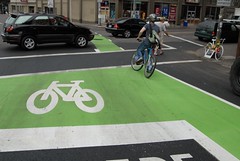
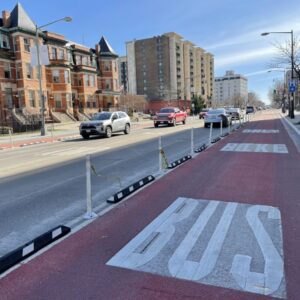
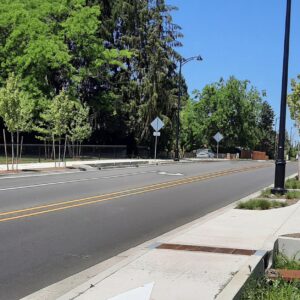
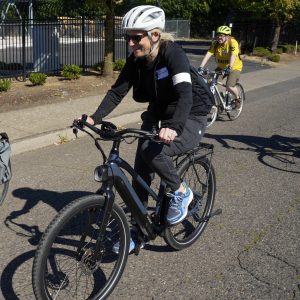
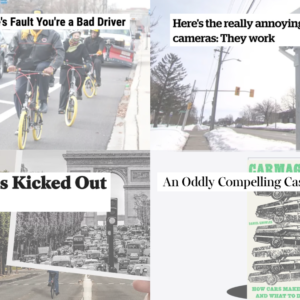
Thanks for reading.
BikePortland has served this community with independent community journalism since 2005. We rely on subscriptions from readers like you to survive. Your financial support is vital in keeping this valuable resource alive and well.
Please subscribe today to strengthen and expand our work.
I don’t think the finding related to multi-use trails counterintuitive at all. Removing the hazzard of big bad cars can lull people into a false sense of security and their awareness and predictable traffic behavior lapse.
Power walkers chatting three abreast, newly training wheel-less kids slaloming randomly, dogs on those extendable leashes, and of course the local club out pushing their anerobic threshholds all traveling in two directions with driveway and road crossings and motor-vehicle excluding bollards – it doesn’t sound safe at all, and yet the grade separated multi-use trail remains the holy grail of cycling facilities in a lot of people’s minds.
I’ll be interested to see what the PSU findings are regarding bike boxes (I confess I don’t understand what they’re supposed to do – seems lik ein encourages shoaling (per BikesnobNYC) and the filtering of slower traffic to the front at stop lights, but I’ve never seen them in action…)
The funny thing is, this is all common sense in other parts of the world. That’s why places like the Netherlands generally avoid shared bicycle/pedestrian facilities, and use on-road, separated bicycle paths. It doesn’t seem like it should be that hard to figure out (and I don’t think it is, I just think we still have more motivation to keep things the way they are than to change them).
@JA in Seattle: I think the general goal of bike boxes is first off, to avoid right-hook accidents at stops by allowing the bikes to cross the intersection before the cars get there, and secondly to just serve as a visible reminder that there is bike traffic to your right.
JA: bike boxes help prevent right hooks by making the bikes more visible to the drivers at the red light.
So far, I have used the bike boxes extensively and at all times of day and have always felt on safe ground. It would be interesting to hear of negative experiences, since I haven’t had problems or seen anyone else having them. Most objections to the green boxes seem to come up when describing them to someone who hasn’t been around them.
(sorry I forgot my last initial…)
I understand the right hook solution aspect, though it seems to me that problem arises more when traffic is moving through a green light than when starting off from a red light. In practice do cyclists come up along the right at a red light then occupy the box in front of the waiting motorists?
Seems like if the motorists are not taking a right turn they’re now stuck behind the cyclists they probably resented passing a minute ago. (not that that’s the greatest crime of the century)
Along my commute route there’s a section of narrow bike lane which ends at the start of a section of multi-use trail (a quasi sidewalk under the doomed Alaskan Way Viaduct), but I won’t use the trail (not because I’m afraid the viaduct will fall on me) but for all the previously mentioned factors. I’m fairly wary of the City’s helpfully intentioned but indifferently executed cycling facilities.
It sounds like PDX puts a lot more thought into it all and maybe I’m envious.
@JAT in Seattle: In practice, it does sometimes happen that cyclists spread out in the box at a red light, but they then have to compress again into the bike lane on the other side of the intersection, unless they’re moving over to the left to turn or whatever (in which case it’s also helpful that they’re ahead of motorized traffic). It’s not the greatest solution, but I haven’t seen it causing any major issues other than some mild annoyance between cyclists trying to merge with each other.
I think at the one shown here on Hawthorne Blvd, the bigger problem is that there is enough cycle traffic at times that it’s difficult to get it all to fit in the narrow painted bike lane. It’s time for an on-street, separated path.
I can see how sidewalks would be dangerous – especially with cars pulling out across them – and I could see how there would be higher likelyhood of crashes occurring on multi-use trails, for all the reasons that JA mentions in #1. But I can’t imagine that crashes on multi-use trails are nearly as damaging as those on the street or sidewalks. It seems a stretch to lump trails and sidewalks together. Is that what the study is suggesting? It seems that way from the quote, but then the story refers only to sidewalks being 1.8 to 16 times more dangerous.
Now I’m curious enough to check out the report :).
Those findings track with my own experiences. I don’t wear a helmet all that often, but I am most likely to wear it on the multi-use path along the Chicago lakefront. It must be one of the most dangerous multi-use paths in the country during late spring and summer. I feel much safer sharing the road with cars than a path with joggers and roller bladers.
Lest we not forget, just because something is safer doesn’t mean it is perceived as such.
Perception of safety is an important asset of multi-use paths. They’ll be an important part of our city bike future, especially to get to that 30% mode share!
The sketchiest parts of MUPs for me is when there are driveways or other intersections with cars passing through. I’m looking forward to the report that has the better data.
JAT 5
“Seems like if the motorists are not taking a right turn they’re now stuck behind the cyclists they probably resented passing a minute ago. (not that that’s the greatest crime of the century)”
Well, I always resent being passed by someone who’s just going to sit at the next red light with me. Maybe bike boxes will help drivers learn that since their average speed through a congested urban area isn’t much more than a cyclist’s, then maybe it’s not really necessary to pass every single cyclist, especially those going at a reasonable clip. On 20th going from NE Broadway all the way to SE Hawthorne, I’ve caught up to the same drivers who have to impatiently pass me after every light.
Another advantage of allowing cyclists to sit in front of cars at red lights is that the air is slightly cleaner in front of a car than to the side or the rear of it.
Elly, I’m surprised by the title you chose for this story. You made it sound like enough research had finally been done, and that conclusive evidence supports the statement that one is safer riding in the bike lane. That would be so cool if it were true, but it doesn’t seem to be the case, as you report…
“These conclusions, the researchers are quick to note, are tentative, pending better data. They only found 23 English language studies that took on the relationship between bicycle safety and infrastructure… The research on injuries and infrastructure that the researchers did uncover is often contradictory and does not use standardized (or even always decipherable) terms to identify different types of facility. There are deep problems with the reporting of data on cycling crashes and injuries.”
Also, your second paragraph does nothing to illustrate your introduction… does it? Or am I missing something?
Your freind,
J
I like the bike box.
I hope it gets people into the habit of always getting in front of, (or behind) and never to the side of, a car stopped at a light.
Besides safety…
I too, like not sitting behind the tail pipe, and the way the bike box lets drivers take note that a passed bicycle is likely to be in front of you again at the light… maybe they’ll chill out a little more if they keep seeing this.
I can’t imagine what the neg would be for those boxes.
Looking only at English-language studies in this particular field = epic fail. I definitely know that at least in the literature from Germany bike lanes fare significantly worse. I suspect this is mostly related to the absence of studies about intersections–the most dangerous place for cyclists on separate facilities (right hooks).
The problem is, that makes terminology all the more complicated – what does German literature mean, for instance, by bike lane? Is it just paint? Is it off to the right side of the road? Is it physically separated from car traffic? Is it on-road, or completely separate from the road?
Given practical experience, the Dutch have probably spent the most time and effort on their cycling network of any country, and they also have the safest traffic in the world (and not just for bikes, but for pedestrians and automobile drivers as well).
I have a feeling what it boils down to is this – infrastructure itself is not necessarily going to help. Well-planned infrastructure can make a big difference. If we were to actually think about our traffic system as a whole, and design it from scratch to accommodate all modes safely and efficiently, what we would get would be vastly superior to all the retrofitting we are doing now. And, I bet it would look more like (not identical to) that in Denmark or The Netherlands.
Amen Dave
What frustrates me is that these studies don’t use the same infrastructure terms/definitions as the AASHTO guidelines. Is a sidepath a sidewalk or a multi-use path?
Jeff Mapes book, Pedaling Revolution, offers a great historical overview of debate between the “take the road” position and bike-lane advocacy.
Hi Jacque — thanks for the friendly critique. In defense of the story’s title, the study is pretty clear that its conclusions are all solid and significant based on the data that exists. The data that currently exists may be problematic but that doesn’t necessarily make any conclusions invalid, or they would not have been able to use it in a peer reviewed study.
I’d be open to changing the title — but am low on ideas for how to convey all of that concisely. Anyone?
As for the exposition, sorry if it isn’t the greatest transition. It always does help to hear feedback.
#12 – Allow me. One negative impact of bicycle-boxes is they’re damaging to the environment. At intersections with bike-boxes in Portland motorists are prohibited from turning right during red-lights. This treatment slows motorist traffic and increases motorist trip-times, which in turn increases the amount of pollution each car generates during a trip involving any bike-box, and a right-hand turn from one.
Furthermore it was my understanding that the bike-boxes were paid for, at least in part, by a federal grant. Since the federal grant was subsequently denied based upon the bike-box not meeting MUTCD standards, there’s some question as to the city’s liability exposure as a result. I consider this negative because there are better things to do with public money than handing it out to Portland citizens injured by an illegal traffic treatment, if true.
The headline is extremely misleading and is just the kind of thing fueling the car vs. bike mentality of the debate. Most people, knowing full-well that this can’t be true, are offended by such an obvious attempt to further an agenda while everybody’s, bike, car, truck, and EMS, trip-times keep going up and up.
I think there is not enough information here. It does not mention the severity of the crashes. There may be more accidents on bike paths, but the would probably be less severe than a collision with a car or truck. Then there are bike lanes and there are bike lanes. I find one of the best places to ride is a wide bike lane along a road with not side streets or parked cars, while one has to be ware of many hazards on an inner city lane in heavy traffic. That said I believe that a properly connected backbone of bicycle lanes along the major arterial roads is the most viable means of providing a sufficiently safe option to encourage larger numbers of people to see cycling as a viable means of transport. To that end I in fact published a short video this week, highlighting the need for continuous bike lanes that do no disappear. Check it out at http://www.youtube.com/watch?v=LPtA3Ng6-n8
“At intersections with bike-boxes in Portland motorists are prohibited from turning right during red-lights. This treatment slows motorist traffic and increases motorist trip-times, which in turn increases the amount of pollution each car generates during a trip involving any bike-box, and a right-hand turn from one.”
This is something anti-bikers love to say:
“Riding a bike through town is bad for the environment because it makes all the cars go slower and wait longer, burning more fuel and causing more pollution.”
Not to say that I have any conclusive evidence, but I wonder about this. Back in the 70’s, during the last oil crisis, the U.S. government mandated the 55mph speed limit to make cars go slower because it used less fuel. I don’t know whether driving slower is necessarily less efficient.
But what about cars that just sit there idling while they are waiting for bikes to clear? Isn’t idling always a waste? Sure it is, but I wonder about two things related to the excessive idling complaint.
First, aren’t there lots of other reasons why a driver has to sit there and idle when they could otherwise be moving? What about pedestrians crossing? What about waiting for another driver to make a left turn? What if I want to turn right, but the cars in front of me are going straight, and there are too many parked cars in the way to sneak by? What about traffic jams caused by just having too many cars (no bikes around)? Why pick on bike boxes as causing more idling than any of these other things?
Secondly, if having bike lanes and boxes entices people to ride rather than drive, what is the balancing effect of making, say, n cars idle for an extra minute along their way vs. deleting x miles of travel by a single car? Do the n extra idle-minutes burn more fuel than x VMT?
I’m not a huge fan of mandatory-use infrastructure, but I don’t think the “bike boxes are bad for the environment” argument works, unless you count the materials and activity of installing them in the first place–all those fumes and plastics and power equipment.
#21 El Biciclero:
I agree with your assessment. I think the cars taken off of the road offsets the “extra pollution” from cars not being able to turn right on red at a small handful of intersections around town.
And going slower does increase your MPG, to a certain extent. As far as I understand, on most “average” vehicles the MPG will increase until a car hits around 50-60 mph, at which point wind resistance starts to bring MPG back down as speed increases past that point. However, driving the speeds mandated on surface streets is less fuel efficient than driving at highway speeds. This doesn’t mean drivers should drive that fast on surface streets, as safety obviously trumps fuel economy.
I’ve complained about cyclists sitting in the right hand lane blocking right turning vehicles already…so in agreement on that one, but an occupied bike lane itself (whether or not a box was present) would stop a right turning vehicle… wouldn’t it?
Also, I just remembered the big negative of the bike box… it doesn’t help at all with the right hook if the traffic is moving, and could give cyclists even more of a false sense of security at the intersection. But all this has been hashed over before a bazzillion times, and still no research that really answers the questions.
re the youtube video linked to comment 20. the guy needs to take the lane. several cars passing within the lane because he is hugging the curb. also, he set himself up for the difficulty in making the right turn by using the striped bike lane in the far left. what you need to do is get over to the far right lane ahead of the turn.
(reverse the usage of “left” and “right” for places where traffic is on the right rather than the left, as this video seems to have been shot in the UK.)
the usual objection to what I am suggesting relates to the subject of the blog post itself: “but the striped lane is over here, and not over there.” and the answer is: very often the striping will mislead you.
in Portland, for example, the bike lane is striped solid all the way to the intersection, and a motorist is forbidden to merge across to make a right turn, but is generally not, repeat not (responding to comment 23) forbidden to make a hard right at the intersection itself. so the striped lane misleads the unschooled cyclist into pulling up alongside a motorist at the intersection, rather than behind, exposing the cyclist to a right hook.
the green box (at least for moment, while there is still some novelty to it) alerts the motorist that a cyclist might be overtaking on the right, but often this just causes hesitation and confusion.
and the green box is worse than useless when the light is changing to green, because it sucks the cyclist (who is not in a position to see the cross light going yellow) in to the right hook.
Vance #19 – “…it was my understanding that the bike-boxes were paid for, at least in part, by a federal grant.”
mo, they weren’t funded with a federal grant – but you’re right, the feds are not particularly pleased.
#25 – The first 14 of those bike-boxes installed were so done with Federal grants. At least that was the intent. I don’t know what funds the rest of them, and whether or not this was retroactively applied to existing, but it was supposed to be fed.
I did a quick search and can’t provide a link. I’m pretty sure the funding source was reported on here. I’ll look around more, and get back.
much better analysis of similar data at http://www.landtransport.govt.nz/research/reports/389.pdf
Elly,
There is research on Sharrows. San Francisco Municipal Transportation Agency, SF Dept. of Parking and Traffic, and Alta Planning studied “shared lane” markings in 2004.
Here’s the report: http://www.sfmta.com/cms/uploadedfiles/dpt/bike/Bike_Plan/Shared%20Lane%20Marking%20Full%20Report-052404.pdf
I was just writing yesterday in my blog that I couldn’t find a report that concludes that on-street bike lanes improve bicyclist safety. I think I’ll have to update that article with the news.
http://www.stevevance.net/planning/2009/11/bike-friendly-neighborhoods-in-chicago-and-beyond/
There seems to be some confusion about the nature of the crashes on multi-use paths and sidewalks (aka sidepaths). “The studies surveyed found that riding on the sidewalk resulted in risks 1.8 to 16 times the risk of cycling on the road. One study found that sidewalk-riding crashes … exclusively occurred while riding against the flow of car traffic on the adjacent road.”
THESE ARE BICYCLE-MOTOR VEHICLE CRASHES AT INTERSECTIONS AND DRIVEWAYS. The crashes studied are not usually pedestrian-bicycle crashes, since such crashes are not usually reported. One main reason that crashes on sidepaths are higher is because they allow cycling in the opposite direction of traffic. Motorists are not looking for traffic in this direction, and thus often don’t see cyclists crossing the road or driveway. Bike lanes do not allow such movements, which is probably why the studies show them to be safer than sidepaths.